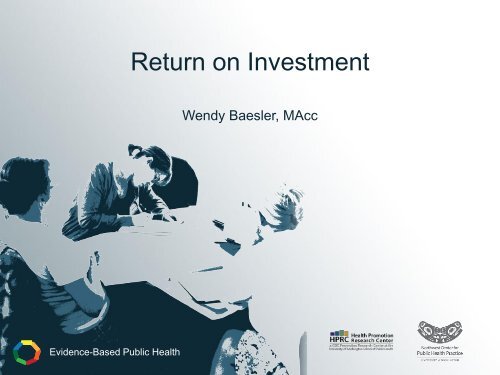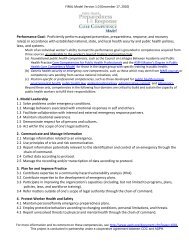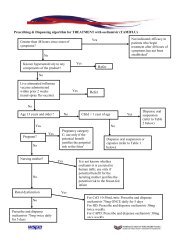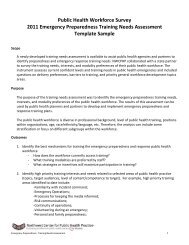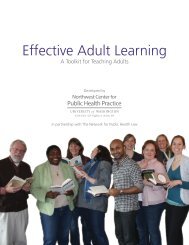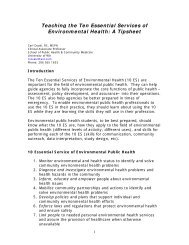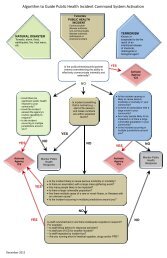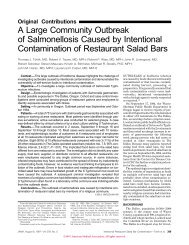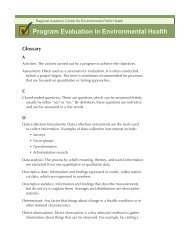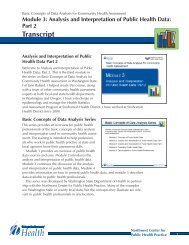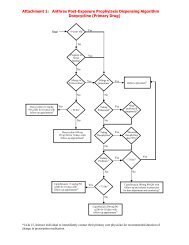Slides - Northwest Center for Public Health Practice
Slides - Northwest Center for Public Health Practice
Slides - Northwest Center for Public Health Practice
Create successful ePaper yourself
Turn your PDF publications into a flip-book with our unique Google optimized e-Paper software.
Return on Investment<br />
Wendy Baesler, MAcc<br />
Evidence-Based <strong>Public</strong> <strong>Health</strong>
From the CDC…<br />
• How do you really know you’re making the most<br />
of your limited resources?<br />
• How do you decide between two promising<br />
program options when you can only af<strong>for</strong>d one?<br />
• How do you demonstrate to decision-makers<br />
that the benefits of your program are worth the<br />
cost?
From the CDC…<br />
The answer: Economic evaluation—a powerful<br />
tool that can help with all these situations.
Motivation <strong>for</strong> Economic Analysis<br />
INPUTS<br />
Resources used<br />
such as money,<br />
time, labor,<br />
supplies<br />
OUTPUTS<br />
Change in<br />
health<br />
outcomes
Value of Economic Evaluation<br />
“More important than deciding whether dollar benefits<br />
exceed dollar costs is the questioning approach inherent in<br />
these frameworks. One cannot assume that a program is<br />
efficacious without evidence, even though prestigious<br />
experts may ‘feel’ that it is. One cannot begin with the<br />
notion that resources are plentiful so that one need make<br />
only some emotional plea in order to be able to mount a<br />
major health program. More attention to defining goals and<br />
to evaluating efficacy should be combined with benefit-cost<br />
analysis if we are to improve the health of the nation.”<br />
—Lester Lave
Cost of Economic Evaluation<br />
“We should keep in mind that it takes many resources<br />
(time, skill, and money) to do CBA well, especially where<br />
the projects are large, complex, and have unique features.<br />
The costs of conducting CBA can be very large. For<br />
example, Thomas Hopkins reported in 1992 that a CBA of<br />
reducing lead in gasoline cost the Environmental Protection<br />
Agency (EPA) roughly $1 million.”<br />
—Boardman, Greenberg, Vining & Weimer
Economic Evaluation Concerns<br />
“Does CBA debase the terms of public discourse? A number of<br />
objections have been raised to the ef<strong>for</strong>t made in CBA to value all<br />
policy impacts in terms of dollars: Pricing goods not normally traded in<br />
markets—<strong>for</strong> example life itself—decreases their perceived value by<br />
implying they can be compared to goods that are traded in markets…”<br />
“Does CBA undermine democracy? Some critics of CBA charge that<br />
it undermines democracy by imposing a single goal, efficiency, in the<br />
assessment of public policies. The general public, politicians, and<br />
even economists, however, very often consider goals reflecting other<br />
values to be relevant.”<br />
—Boardman, Greenberg, Vining & Weimer
Various Measures of Economic Evaluation<br />
Cost effectiveness analysis<br />
Cost utility analysis<br />
Cost benefit analysis<br />
Cost per unit of health<br />
outcome<br />
Cost per life saved or per<br />
year of life saved<br />
Benefits : Costs<br />
Return on investment<br />
Social return on investment<br />
Percentage showing benefits<br />
as percent of costs<br />
ROI from a societal<br />
perspective
Cost Benefit Analysis<br />
• A <strong>for</strong>m of economic evaluation that standardizes costs<br />
and benefits into dollars and compares them<br />
• Ratio Benefits : Costs<br />
• Fraction Benefits<br />
Costs<br />
www.jala.com/homecba.php<br />
www.americantrails.org/resources/health/trailinvest.html
Return on Investment<br />
ROI =<br />
Benefits of investment - Amount invested<br />
Amount invested<br />
Decision rule: If ROI is greater than 0%, the program’s<br />
benefits exceed its costs.
Traditional ROI Calculation<br />
Purchase a share of stock <strong>for</strong><br />
$82 and sell it <strong>for</strong> $91. What<br />
is the ROI?<br />
(91 - 82) 8<br />
= = 11%<br />
82 82
ROI Expressed as a Ratio<br />
Benefits : Costs<br />
Each benefits and costs are<br />
divided by costs so that the ratio is<br />
some number : 1<br />
Abstract of Trust <strong>for</strong> America's <strong>Health</strong> in July 2008<br />
www.healthyamericans.org/reports/prevention08
Sample Calculations<br />
Program ABC<br />
Benefits: $6,000,000<br />
Costs: $5,260,000<br />
Compute cost benefit ratio: 1.14 : 1<br />
Compute ROI as percentage: 14%<br />
Compute ROI as a ratio: 1.14 : 1<br />
Program XYZ<br />
Benefits: $400,000<br />
Costs: $432,000<br />
Compute cost benefit ratio: 0.93 : 1<br />
Compute ROI as percentage: - 7%<br />
Compute ROI as a ratio: 0.93 : 1
You try a calculation…<br />
Benefits = $52,000 and Costs = $48,000<br />
What is the return on investment expressed as a percent?<br />
A. $4,000<br />
B. 83%<br />
C. 8.3%<br />
D. 7.7%
Steps to Determining Costs and Benefits<br />
1. Specify the set of alternative projects<br />
2. Decide whose benefits and costs count<br />
3. Catalog the impacts and select measurements<br />
4. Predict the impacts quantitatively over project life<br />
5. Monetize (attach dollar values to) all impacts<br />
6. Discount benefits and costs to obtain present values<br />
7. Per<strong>for</strong>m the net present value of each alternative<br />
8. Per<strong>for</strong>m sensitivity analysis<br />
9. Make a recommendation
Perspective of an Economic Analysis<br />
Viewpoint from which the<br />
economic evaluation is<br />
conducted. Costs to whom?<br />
Benefits to whom?<br />
Perspectives <strong>for</strong> ROI or CBA<br />
1. Patient<br />
2. Provider<br />
3. Payer<br />
4. <strong>Health</strong> care system<br />
5. Society (this is social ROI)
Patient Perspective<br />
Costs born by the patient<br />
and benefits accruing to<br />
the patient are relevant.<br />
Example: Should I get a flu<br />
shot this year?
Provider Perspective<br />
People or institutions<br />
providing health-related<br />
services (physicians,<br />
hospitals, nursing homes,<br />
public health clinics, and local<br />
and state health departments).<br />
Provider costs and provider<br />
benefits are relevant.<br />
Example: Should we set up<br />
and operate a childhood<br />
immunization reminder<br />
system?
Payer Perspective<br />
Person or entity ultimately responsible <strong>for</strong> the financial<br />
costs (households, businesses, private insurers, Medicare<br />
or Medicaid, or government). Costs to the payer and<br />
benefits to the payer are relevant.<br />
Example: Should General Motors adopt a health promotion<br />
program, LifeSteps, designed to improve employees’ and<br />
dependents' health status?
<strong>Health</strong> Care System Perspective<br />
Costs <strong>for</strong> the entire health care system are relevant<br />
as are benefits to the entire health care system.<br />
Example: Considering a program to treat STDs.
Society Perspective (SROI)<br />
Broadest perspective. Consider all costs regardless of who<br />
pays them and all benefits regardless of who accrues them.<br />
Example: ROI of Mobile <strong>Health</strong>care by Oriol et.al. 2009
Social Return on Investment<br />
• A return on investment that considers the benefits to the<br />
entire society as well as the costs to the entire society.<br />
• Differs from return on investment only in perspective.
Steps to Determining Costs and Benefits<br />
1. Specify the set of alternative projects<br />
2. Decide whose benefits and costs count<br />
3. Catalog the impacts and select measurements<br />
4. Predict the impacts quantitatively over project life<br />
5. Monetize (attach dollar values to) all impacts<br />
6. Discount benefits and costs to obtain present values<br />
7. Per<strong>for</strong>m the net present value of each alternative<br />
8. Per<strong>for</strong>m sensitivity analysis<br />
9. Make a recommendation
Identifying Costs & Benefits<br />
• Goal: express costs and<br />
benefits in monetary<br />
terms.<br />
• Start with a list of costs<br />
and benefits in words.<br />
• Do your best to determine<br />
whether those costs and<br />
benefits can be measured.<br />
You will have to estimate<br />
more than you may be<br />
com<strong>for</strong>table with.
Types of Benefits<br />
Direct benefits<br />
Indirect benefits<br />
Intangible benefits<br />
Medical dollars directly<br />
saved<br />
Potential increases in<br />
earnings or productivity or<br />
medical dollars indirectly<br />
saved, reduced disability,<br />
increased life expectancy,<br />
etc.<br />
Psychological benefits of<br />
health, reduced pain and<br />
suffering, peace of mind, etc.
Measuring Direct Benefits<br />
• Direct benefits are medical dollars saved.<br />
• Tricky because “…you’re measuring something that<br />
doesn’t happen.” (Kimberly Redding, M.D.)I*<br />
• One option: Use estimates of what it would have cost.<br />
Example: the mobile healthcare provides a visit that had<br />
a 80% chance of becoming an emergency room visit that<br />
costs on average $923.<br />
• Another option: Use research estimates of cost of that<br />
illness either annually or over a lifetime.<br />
*Director of <strong>Health</strong> Promotion and Disease Prevention,<br />
Georgia Department of Community <strong>Health</strong>, Division of <strong>Public</strong> <strong>Health</strong>
Measuring Indirect Benefits: Human Capital<br />
Approach<br />
• Value of life saved or extended.<br />
– QALY = Quality-Adjusted Life Year<br />
– DALY = Disability-Adjusted Life Year<br />
• Value of a life year derived from value of life. The value<br />
of a year of life ranges from $70,000 to $175,000<br />
depending on the source of the estimation.<br />
• Value of life ranges from $300,000 to $2,000,000<br />
depending upon the source of the estimate.
Measuring Indirect Benefits: Human Capital<br />
Approach<br />
Australian study estimate<br />
• Value of life = Loss of work<strong>for</strong>ce productivity + Loss of<br />
household productivity + Loss of quality of life<br />
• $1,400,000 = $540,000. $500,000 + $319,000.<br />
FAA (1980 citation)<br />
• Value of life = $300,000 based on recent court awards<br />
Nuclear Regulatory Commission<br />
• Cost of premature death = $1,000,000
Measuring Indirect Benefits: Survey Methods<br />
• Revealed preference: A survey figures out the value of<br />
something by asking questions around the subject.<br />
Example: Salary expected in post office with 0 risk of<br />
death vs. salary expected in post office with 2% chance<br />
of death.<br />
• Stated preference: Ask directly what a person would be<br />
willing to pay <strong>for</strong> the benefit.<br />
Example: How much would you pay <strong>for</strong> security service<br />
that reduces risk of terrorist attack on an airplane that<br />
you are flying on?<br />
• A person will pay from $250,000 to $500,000 <strong>for</strong> a<br />
decrease in the probability of death.
Types of Costs<br />
Direct costs<br />
Value of people, equipment,<br />
facilities, and supplies used<br />
in a particular program<br />
including appropriately<br />
allocated shared costs<br />
Indirect costs<br />
Costs not directly related to<br />
the program (time taken off<br />
work to receive medical<br />
treatment, childcare, travel<br />
costs, productivity loss due<br />
to side effects of treatments)
Types of Costs<br />
Intangible costs<br />
Non-cash costs<br />
Opportunity costs<br />
Otherwise preferred private<br />
behavior cost<br />
Emotional anxiety, fear, pain,<br />
suffering, etc. (e.g., pain<br />
from immunization)<br />
Costs of volunteers and<br />
donated resources<br />
Benefit of the <strong>for</strong>egone<br />
alternative<br />
If a public health message<br />
convinces you to bike with a<br />
helmet, but you prefer to ride<br />
without, that loss is a cost
Measuring Direct Costs<br />
• Cost of all personnel, equipment, facilities, and supplies<br />
used. Shared costs should be appropriately allocated.<br />
• Ideally include only the avoidable costs—the costs that<br />
would go away if the program went away. Example:<br />
administrative costs allocated to the program are usually<br />
not avoidable.
Measuring Indirect Costs<br />
• Can only be estimated. No standard practices exist.<br />
• Opportunity cost is the value that could be received<br />
from the <strong>for</strong>egone alternative.<br />
Example: Personnel <strong>for</strong> a mobile health van.
Alternative Is ROI in Words<br />
• Many costs not tracked<br />
• Many benefits difficult to<br />
determine<br />
Photo: John Johnston
ROI Analysis of Bikes on Busses (BOB)<br />
Costs<br />
• Capital cost of purchasing racks<br />
• Maintenance cost of<br />
repairing/replacing racks<br />
• Administrative cost of day-to-day<br />
operations<br />
• Marketing costs of program<br />
• Insurance claims and incidents<br />
• Permitting process and training<br />
• Funding of bicycle facilities to<br />
access transit<br />
• Provision of bicycle parting<br />
• Bicycles abandoned on racks<br />
• Route delay and increased dwell<br />
time<br />
• Impact of rack capacity limitations<br />
Benefits<br />
• BOB ridership/boardings<br />
• Expansion of transit service area<br />
• Attraction of new transit riders<br />
• More frequent use of transit<br />
• Bicycle locker rental fees<br />
• Improved bicycle safety<br />
• Reduction in traffic congestion<br />
• Improved air quality<br />
• Promotion of healthy lifestyle<br />
• Improved transit agency image<br />
• Increased mobility
Let’s consider a public health program to increase<br />
hand washing…<br />
Lets adopt a society perspective<br />
Everybody type a cost of such a program in the chat box<br />
Everybody type a benefit of such a program in the chat box
Steps to Determining Costs and Benefits<br />
1. Specify the set of alternative projects<br />
2. Decide whose benefits and costs count<br />
3. Catalog the impacts and select measurements<br />
4. Predict the impacts quantitatively over project life<br />
5. Monetize (attach dollar values to) all impacts<br />
6. Discount benefits and costs to obtain present values<br />
7. Per<strong>for</strong>m the net present value of each alternative<br />
8. Per<strong>for</strong>m sensitivity analysis<br />
9. Make a recommendation
Computing Present Values<br />
If the costs or benefits are far in the future, state those<br />
costs or benefits in today’s dollars.<br />
Present value = Future value / (1+i) n<br />
n = number of years in future<br />
i = annual interest rate or discount rate = 3%<br />
Can use Present Value Tables<br />
Can use Excel =PV(rate,nper,pmt,[fv],[type])<br />
Sum of the present value of all the future net cash flows is<br />
called the Net Present Value. If NPV is greater than 0, the<br />
project is financially worthwhile.
Partial Present Value Table<br />
Present value of $1 to be received at the end of n periods (PV)<br />
Period 1.00% 2.00% 3.00% 4.00%<br />
1.00 0.9901 0.9804 0.9709 0.9615<br />
2.00 0.9803 0.9612 0.9426 0.9246<br />
3.00 0.9706 0.9423 0.9151 0.8890<br />
4.00 0.9610 0.9238 0.8885 0.8548<br />
5.00 0.9515 0.9057 0.8626 0.8219
Time Period Adjustments<br />
Year 1 Year 2 Year 3 Year 4 Year 5 Total<br />
Benefits 5,000 5,000 70,000 100,000 160,000 340,000<br />
Costs 100,000 30,000 35,000 40,000 45,000 250,000<br />
ROI 36.0%<br />
Benefit -<br />
Cost<br />
PV net<br />
benefits<br />
PV<br />
Costs<br />
-95,000 -25,000 35,000 60,000 115,000 90,000<br />
-92,245 -23,575 32,030 53,280 99,245 68,735<br />
97,100 28,290 32,025 35,520 38,835 231,770<br />
ROI 29.8%
Steps to Determining Costs and Benefits<br />
1. Specify the set of alternative projects<br />
2. Decide whose benefits and costs count<br />
3. Catalog the impacts and select measurements<br />
4. Predict the impacts quantitatively over project life<br />
5. Monetize (attach dollar values to) all impacts<br />
6. Discount benefits and costs to obtain present values<br />
7. Per<strong>for</strong>m the net present value of each alternative<br />
8. Per<strong>for</strong>m sensitivity analysis<br />
9. Make a recommendation
ROI Studies in <strong>Public</strong> <strong>Health</strong><br />
• Trust <strong>for</strong> America’s <strong>Health</strong> report included public health<br />
programs that produced very large returns on investment<br />
• Community Preventative Services Website<br />
• “An Ounce of Prevention” by the CDC in 1999<br />
• Minnesota Institute of <strong>Public</strong> <strong>Health</strong> blog<br />
• Worksite health promotion<br />
• Value-based Insurance Design
Summary<br />
• Cost benefit analysis<br />
• Return on investment<br />
• Social return on investment<br />
• ROI has limitations<br />
• Designing a program and building in measurement of<br />
costs and benefits at the onset is important


